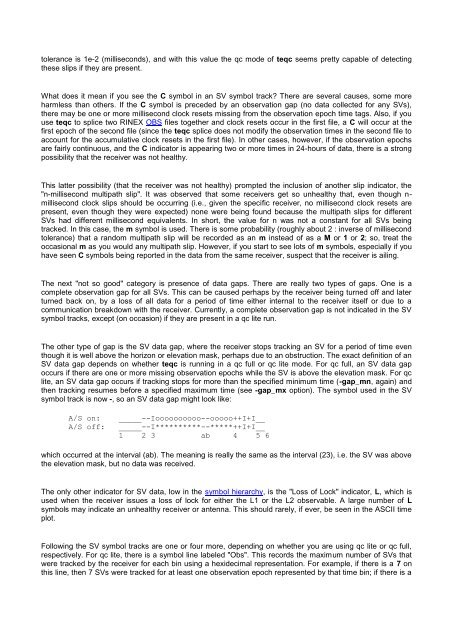Interpreting teqc's qc Mode Output Section 21. - Inpe
Interpreting teqc's qc Mode Output Section 21. - Inpe
Interpreting teqc's qc Mode Output Section 21. - Inpe
Create successful ePaper yourself
Turn your PDF publications into a flip-book with our unique Google optimized e-Paper software.
tolerance is 1e-2 (milliseconds), and with this value the <strong>qc</strong> mode of te<strong>qc</strong> seems pretty capable of detectingthese slips if they are present.What does it mean if you see the C symbol in an SV symbol track? There are several causes, some moreharmless than others. If the C symbol is preceded by an observation gap (no data collected for any SVs),there may be one or more millisecond clock resets missing from the observation epoch time tags. Also, if youuse te<strong>qc</strong> to splice two RINEX OBS files together and clock resets occur in the first file, a C will occur at thefirst epoch of the second file (since the te<strong>qc</strong> splice does not modify the observation times in the second file toaccount for the accumulative clock resets in the first file). In other cases, however, if the observation epochsare fairly continuous, and the C indicator is appearing two or more times in 24-hours of data, there is a strongpossibility that the receiver was not healthy.This latter possibility (that the receiver was not healthy) prompted the inclusion of another slip indicator, the"n-millisecond multipath slip". It was observed that some receivers get so unhealthy that, even though n-millisecond clock slips should be occurring (i.e., given the specific receiver, no millisecond clock resets arepresent, even though they were expected) none were being found because the multipath slips for differentSVs had different millisecond equivalents. In short, the value for n was not a constant for all SVs beingtracked. In this case, the m symbol is used. There is some probability (roughly about 2 : inverse of millisecondtolerance) that a random multipath slip will be recorded as an m instead of as a M or 1 or 2; so, treat theoccasional m as you would any multipath slip. However, if you start to see lots of m symbols, especially if youhave seen C symbols being reported in the data from the same receiver, suspect that the receiver is ailing.The next "not so good" category is presence of data gaps. There are really two types of gaps. One is acomplete observation gap for all SVs. This can be caused perhaps by the receiver being turned off and laterturned back on, by a loss of all data for a period of time either internal to the receiver itself or due to acommunication breakdown with the receiver. Currently, a complete observation gap is not indicated in the SVsymbol tracks, except (on occasion) if they are present in a <strong>qc</strong> lite run.The other type of gap is the SV data gap, where the receiver stops tracking an SV for a period of time eventhough it is well above the horizon or elevation mask, perhaps due to an obstruction. The exact definition of anSV data gap depends on whether te<strong>qc</strong> is running in a <strong>qc</strong> full or <strong>qc</strong> lite mode. For <strong>qc</strong> full, an SV data gapoccurs if there are one or more missing observation epochs while the SV is above the elevation mask. For <strong>qc</strong>lite, an SV data gap occurs if tracking stops for more than the specified minimum time (-gap_mn, again) andthen tracking resumes before a specified maximum time (see -gap_mx option). The symbol used in the SVsymbol track is now -, so an SV data gap might look like:A/S on:A/S off:_____--Ioooooooooo--ooooo++I+I_______--I**********--*****++I+I__1 2 3 ab 4 5 6which occurred at the interval (ab). The meaning is really the same as the interval (23), i.e. the SV was abovethe elevation mask, but no data was received.The only other indicator for SV data, low in the symbol hierarchy, is the "Loss of Lock" indicator, L, which isused when the receiver issues a loss of lock for either the L1 or the L2 observable. A large number of Lsymbols may indicate an unhealthy receiver or antenna. This should rarely, if ever, be seen in the ASCII timeplot.Following the SV symbol tracks are one or four more, depending on whether you are using <strong>qc</strong> lite or <strong>qc</strong> full,respectively. For <strong>qc</strong> lite, there is a symbol line labeled "Obs". This records the maximum number of SVs thatwere tracked by the receiver for each bin using a hexidecimal representation. For example, if there is a 7 onthis line, then 7 SVs were tracked for at least one observation epoch represented by that time bin; if there is a
















